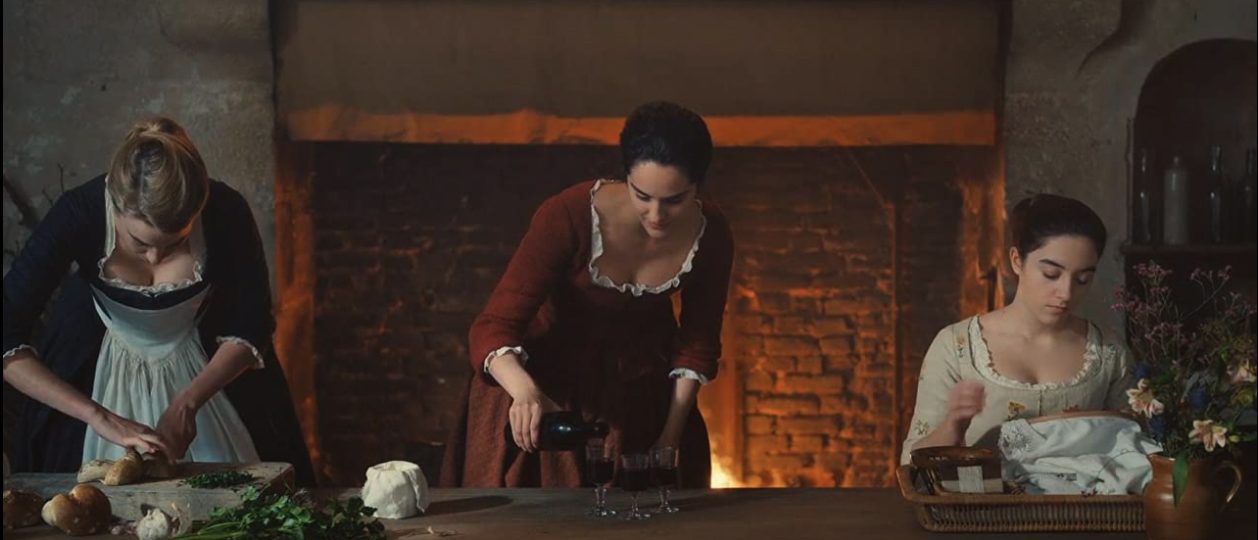——— post by Amelia Ferry*
Portrait of a Lady on Fire (Portrait de la jeune fille en feu; dir. C. Sciamma, 2019) adapts the classical myth of Orpheus and Eurydice. Set on an island in 18th-century Bretagne, Sciamma’s screenplay paints the tale of Orpheus’ attempts to recover the beloved Eurydice from the dead, though in this innovative adaptation both the artist and the beloved are women. The characters of Marianne and Héloïse represent the famous musician and the dead lover in this “queer feminist love story” that showcases the loss of love as a modern tragedy (Kaminsky, 2019). Marianne’s status as a representation of Orpheus is built by her love for Héloïse and her love for art which allows Marianne to express her love for Héloïse. At the end of the film, “Marianne goes on to paint, tellingly, an‘Orpheus and Eurydice’ [an acknowledgement alà Hutcheon’s Theory of Adaptation] as well as the titular ‘Portrait’ just as Orpheus had continued on to sing ‘tales of ‘forbidden love’ after he had looked back at Eurydice and lost her to the Underworld” (Stevens, 2020), cf. Ov. Met. 10. Héloïse’s representation of Eurydice equates to a “hell” created by a man’s world compelling her to marry Mr. Delamarche, a man she cannot love. The film showcases a dark and compelling atmosphere amidst a beautiful scenery. The haunting ruins and water from the island emphasize the presence of the underworld to this gripping story.
This film is built by its courage and ability to embrace the hard truths of the world. Through the acknowledgement of the Orpheus myth, when Héloïse overtly reads a French translation of Ovid Metamorphoses 10.16-63 and characters react to it tellingly (1:11:10-1:14:30), Sciamma prepares the audience for an unhappy ending. The anticipation of the heartache adds a somber and bittersweet atmosphere to the rest of the film, where the audience and the characters are constantly waiting for the end, for the two women to lose each other. That is what makes the film so beautiful, that it does not shy away from the pain but completely and utterly embraces it. Sciamma’s myth accentuates the story of two women being forced by an unforgiving society to give up their love for each other. This artistic film thinks through the myth of Orpheus and delivers a social commentary on how the stories of women and LGBTQ individuals so often end in tragedy.
—— Amelia Ferry, a student at Brigham Young University, spun this piece from a paper she wrote for ClCv 261 F2020 “Greek and Roman Civilization and Literature in Film”
OGCMA = OrpheusEurydice2.0100_Sciamma
Citations
Portrait de la juene fille en feu (Portrait of a Lady on Fire). Dir. Celine Sciamma. Pyramide Films, 2019.
Kaminsky, Lauren. “Burning Gaze”. Film Comment 55.6 (2019): 42-45. Web.
O’Falt, Chris. 2020. “’Portrait of a Lady on Fire’ Cinematography: the perfect 18th century digital painting.” IndieWire 28 Feb 2020 https://www.indiewire.com/2020/02/portrait-of-a-lady-on-fire-cinematography-claire-mathon-celine-sciamma-1202214143/ . Accessed 7 Jan 2021.
Stevens, Benjamin O. 2020 “Not the Lover’s Choice but the Poet’s: Classical Receptions in Portrait of a Lady on Fire”. Frontieres. https://publications-prairial.fr/frontiere-s/index.php?id=258 . Accessed 4 Jan 2021.



